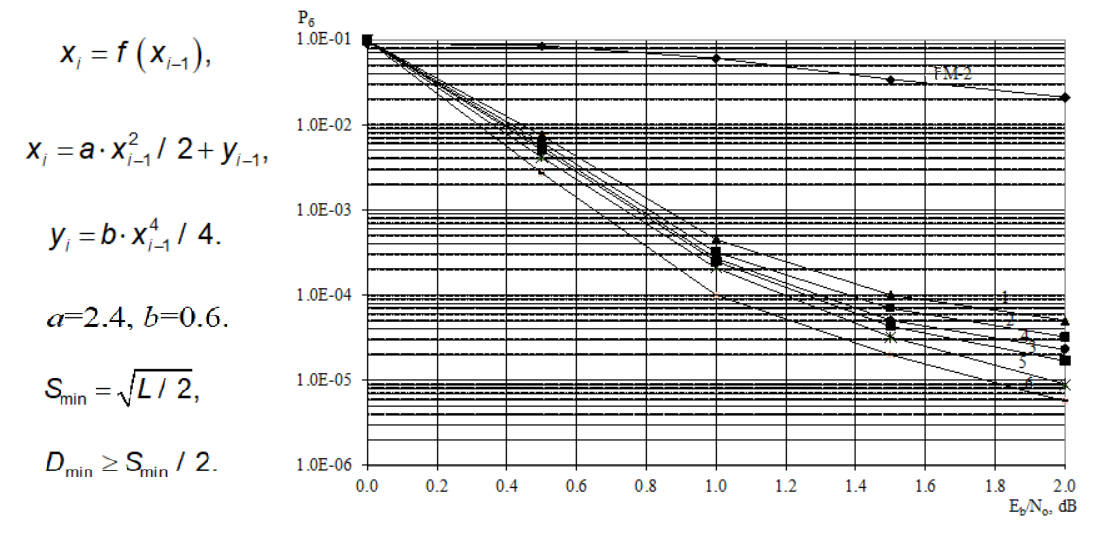Modification of chaotic interleaver for turbo codes with a change to the duffing equation and accounting for the distance spectrum of the code
DOI:
https://doi.org/10.15587/1729-4061.2023.292850Keywords:
chaotic interleaver modification, Duffing equation, Turbo codes, weight distribution, energy efficiencyAbstract
Various types of interleavers in turbo codes and their parameters affecting the efficiency of turbo codes are considered. It is noted that the type of interleaver directly affects the efficiency and error correcting of turbo codes. Also, the efficiency of turbo codes is influenced by the parameters of the minimum distance, the length of interleaver, and the distance spectrum of the code.
A modification of the chaotic interleaver of turbo codes is proposed with the change of the equation to the Duffing and with examining the code's distance spectrum with the condition of increasing the code's distance between the code words with a small weight. The algorithm for modifying the chaotic interleaver with the Duffing equation and with examining the code's distance spectrum of turbo codes is presented. The characteristics of the modified chaotic interleaver with the Duffing equation and with examining the code's distance spectrum of turbo codes according to various parameters of turbo codes are given. This modification of the interleaver of turbo codes increased the minimum distance between elements for different lengths of the interleaver and polynomials of the turbo code by 10 % …33 %. Given this, there was an increase in the energy efficiency of the turbo codes by 0,05, …, 0,25 dB in comparison with a chaotic interleaver without modification at the same value of the bit error probability. When increasing the length of the modified chaotic interleaver with the Duffing equation and applying distance spectrum of the code the increasing the energy efficiency of the turbo code slows down compared to the chaotic interleaver without modification.
The application scope of the modified chaotic interleaving with the Duffing equation and with examining the code's distance spectrum of turbo codes is the infocommunication channels for mobile, wired, and satellite communications
References
- Berrou, C., Glavieux, A., Thitimajshima, P. (1993). Near Shannon limit error-correcting coding and decoding: Turbo-codes. Proceedings of ICC ’93 - IEEE International Conference on Communications. doi: https://doi.org/10.1109/icc.1993.397441
- Mousavi, H., Amiri, I. S., Mostafavi, M. A., Choon, C. Y. (2019). LTE physical layer: Performance analysis and evaluation. Applied Computing and Informatics, 15 (1), 34–44. doi: https://doi.org/10.1016/j.aci.2017.09.008
- Alebady, W. Y., Hamad, A. A. (2023). Concatenated turbo polar-convolutional codes based on soft cancellation algorithm. Physical Communication, 58, 102010. doi: https://doi.org/10.1016/j.phycom.2023.102010
- Heegard, C., Wicker, S. B. (1999). Turbo Coding. Springer, 206. doi: https://doi.org/10.1007/978-1-4757-2999-3
- Andrews, K., Heegard, C., Kozen, D. (1997). A Theory of Interleavers. Available at: https://www.researchgate.net/publication/2264878_A_Theory_of_Interleavers
- Jinhong Yuan, Vucetic, B., Wen Feng. (1999). Combined turbo codes and interleaver design. IEEE Transactions on Communications, 47 (4), 484–487. doi: https://doi.org/10.1109/26.764913
- Dyrda, V., Dyrda, O. (2002). Shchodo pobudovy efektyvnykh heneratoriv psevdovypadkovykh chysel. Naukovi pratsi ONAZ im. O.S. Popova, 1, 71–75.
- Dolinar, S., Divsalar, D. (1995). Weight Distributions for Turbo Codes Using Random and Nonrandom Permutations. TDA Progress Report 42-12, 56–65. Available at: https://www.researchgate.net/publication/243773610_Weight_Distributions_for_Turbo_Codes_Using_Random_and_Nonrandom_Permutations
- Topalov, V., Zaharchenko, N., Kononovich, V. (2008). Modifikatsiya peremezhitelya s kodovym sootvetstviem. Eastern-European Journal of Enterprise Technologies, 35, 26–30.
- Sahnoune, A., Berkani, D. (2021). On the performance of chaotic interleaver for turbo codes. SN Applied Sciences, 3 (1). doi: https://doi.org/10.1007/s42452-021-04147-w
- Urrea, C., Kern, J., López-Escobar, R. (2022). Design of Chaotic Interleaver Based on Duffing Map for Turbo Code. Symmetry, 14 (12), 2529. doi: https://doi.org/10.3390/sym14122529
- Bazzi, L., Mahdian, M., Spielman, D. A. (2009). The Minimum Distance of Turbo-Like Codes. IEEE Transactions on Information Theory, 55 (1), 6–15. doi: https://doi.org/10.1109/tit.2008.2008114

Downloads
Published
How to Cite
Issue
Section
License
Copyright (c) 2023 Vladislav Topalov, Iryna Tregubova, Mykola Severyn, Iryna Hurklis

This work is licensed under a Creative Commons Attribution 4.0 International License.
The consolidation and conditions for the transfer of copyright (identification of authorship) is carried out in the License Agreement. In particular, the authors reserve the right to the authorship of their manuscript and transfer the first publication of this work to the journal under the terms of the Creative Commons CC BY license. At the same time, they have the right to conclude on their own additional agreements concerning the non-exclusive distribution of the work in the form in which it was published by this journal, but provided that the link to the first publication of the article in this journal is preserved.
A license agreement is a document in which the author warrants that he/she owns all copyright for the work (manuscript, article, etc.).
The authors, signing the License Agreement with TECHNOLOGY CENTER PC, have all rights to the further use of their work, provided that they link to our edition in which the work was published.
According to the terms of the License Agreement, the Publisher TECHNOLOGY CENTER PC does not take away your copyrights and receives permission from the authors to use and dissemination of the publication through the world's scientific resources (own electronic resources, scientometric databases, repositories, libraries, etc.).
In the absence of a signed License Agreement or in the absence of this agreement of identifiers allowing to identify the identity of the author, the editors have no right to work with the manuscript.
It is important to remember that there is another type of agreement between authors and publishers – when copyright is transferred from the authors to the publisher. In this case, the authors lose ownership of their work and may not use it in any way.









